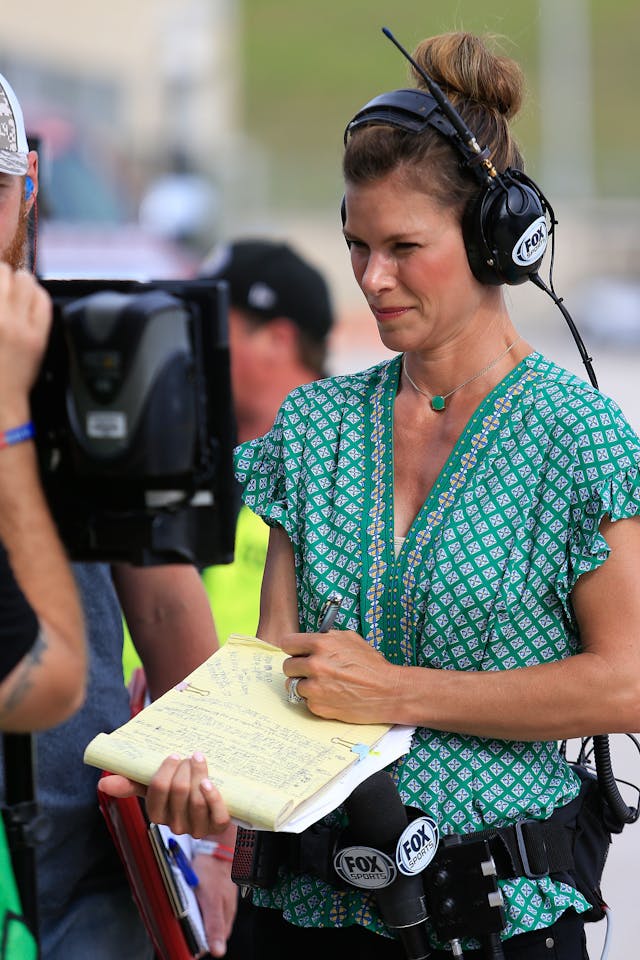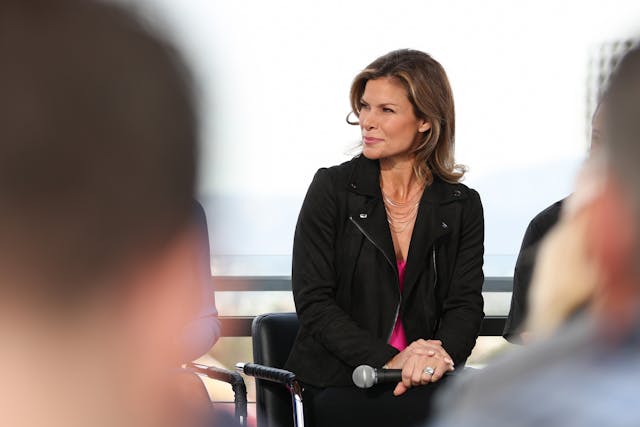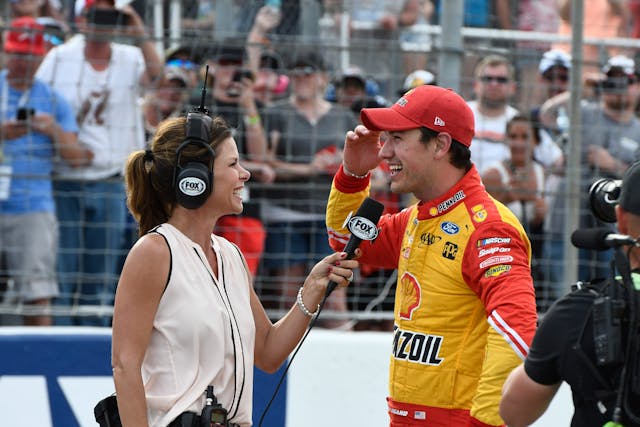Jamie Little’s road to play-by-play was day by day
“Covering racing isn’t a job. It’s a lifestyle,” asserts motorsport broadcaster Jamie Little. “The news comes in every day, every hour. You have to stay on top of everything,”
For 17 years, now, Little has thrived in this nonstop grind, taking copious notes, building relationships, and asking the tough, relevant questions. By virtue of her commitment, she has ascended the broadcasting ladder; in 2021 she became professional motorsports’ first female play-by-play announcer.
We caught up with Little, ahead of her third season as part-time anchor of the ARCA Menards Series booth—and ninth year covering NASCAR for Fox—at her home office in Indianapolis. Flanked by her four dogs, including her Pitbull “Fancy,” and several shelves of racing memorabilia, she recounts her formative years before she ever held a pit mic.
Starting young
While growing up in Lake Tahoe, Little got bit by the speed bug early on. When she was five her father first gave her a ride on the back of his dirt bike. “I remember that feeling and the smell. It was such a visceral feeling and it’s hard to explain,” says Little. “But it never went away.”
Little jumped head-first into the world of Supercross.
“I got rid of my horse posters and suddenly I was all about dirt bikes,” says Little. “I would be in class, not paying attention, reading my Dirt Rider magazines.
“People wondered where this was all coming from and my mom was not impressed.”
At 16, Little attended—snuck into, more accurately—her first Supercross race. She waited in line for an autograph from young standout Jeremy McGrath.
By 18, Little was looking to infiltrate the sport rather than attend college. “I wasn’t a big fan of school at the time. One day, it just dawned on me: I need to tell the stories of these riders, these athletes. I know I can do that job.”
Full speed ahead
At one of the televised moto races, Little approached a stranger holding an ESPN mic. “I said ‘Hey, I want to do what you’re doing. How do I get involved?’”
The ESPN announcer pointed her to local desert races in Southern California. From there, she landed a gig on MotoWorld, ESPN’s long-standing motorcycle racing news program that featured the likes of Dave Despain and Larry Maiers.
Eventually, in 2002, Little graduated to moto’s main stage and covered Supercross and outdoor motocross for ESPN. She even spent time interviewing stunt cyclists and other extreme sport athletes for the network’s annual X Games coverage.

Throughout the journey, Little got closer with the riders. She felt things had come full circle when she was granted a sit-down interview with her hero, Jeremy McGrath. Then, “like one of the cool kids,” she spent a week at Travis Pastrana’s house to produce a written feature story.
“Telling stories, interviewing people, being in the action—I learned that I absolutely loved that job.”
Little spun her early success into her next gig with ESPN. “I realized that I had a way with interviewing and that people responded well to my questions. That I made me want to keep going in that direction.” Her next step: IndyCar pit reporting.
In the pits

Little was now covering the hottest stories from IndyCar’s open-wheel grid, right alongside active racers and stars from the sport’s past. She covered her first Indy 500 in 2004.
“Pit reporting is all about your relationships and sharing those stories that nobody else has access to in that moment or that weekend.
“I remember when Parnelli Jones cried during one of my interviews,” says Little. “And when I interviewed A.J. Foyt, my heart was jumping out of my chest so hard that I could hear my heartbeat in my headphones.
“The way he responded; it was like I was another reporter. That’s when I said to myself, ‘Okay, I don’t want to be the best girl on pit road, I want to be the best reporter on pit road.’”
Plunge in NASCAR

When ESPN landed a contract with NASCAR, it tasked Little with pit reporting. “NASCAR is the hardest. It takes a while to get in,” says Little. “If you’re an outsider you’re not going to be granted access.”
She fought hard to break into the close-knit community. “It’s all about being precise and to the point. You have to ‘watch the ball.’ In our sport that ball is a car,” says Little. “You have to listen to people ask questions—questions that are pertinent to subject and pertinent to the fan.”
Eventually, Little became a member of the NASCAR fraternity. “When you get Tony Stewart to answer your actual questions and not ridicule you—when he actually listens and responds—that’s when you cross over and have their respect. Then they’re breaking news to you or giving something to you that other people are replicating.”

In 2015, Little joined Fox, swapping logos on her pit-lane Nomex outfit but retaining the same position. “NASCAR is where I want to be.”
On a typical race weekend, Little is assigned half of the 40-car field, which is a challenge in itself because, as Little points out, “In NASCAR, there’s a fan for every driver in the field.”
Production meetings and plenty of notes are part of the prep. “My style is very sloppy, very old-school,” she says. “I write everything down and I don’t use anything electronic.” During coverage, while the booth is discussing a given driver, Little will buzz in letting the announcers know that she can add something on the driver. From there, they’ll throw coverage to her down in pit lane.

Little also conducts pre- and post-race interviews with drivers. “The most exciting part of my job is interviewing the winner, especially for the Daytona 500,” she says. “The raw, pure emotion you see on them. They have spent their entire life trying to get to that point, and you get to be with them in that moment. You get to bring it out, so the world can see it and hear it.”
Bird’s-eye view

As for her latest role as play-by-play announcer? “It takes such a different skill set compared to pit reporting,” Little says. “It’s like you’re a traffic control cop.” Compared to pounding pavement for hours on end, hunting for stories, life in an air-conditioned booth is assuredly different.
She adds: “I wasn’t sure I would love it, but I was willing to fail.”
Even years after she first approached the reporter with the ESPN mic, Little hasn’t lost her brazen attitude. The “hard-headedness,” as she calls it, and intrinsic motivation is requisite for the daily grind, ping-ponging across the United States chasing race cars, chasing stories.
After all, it’s not a sport, it’s a lifestyle.
Tune in to Fox on Sunday, February 19th to catch Little during the 2023 Daytona 500.



I miss the coverage of the past. We have has some real greats like Dr. Jerry Punch and others that really did a great job. Today they too often hire to fill a quota or just to be cool. Or Chris Economaki.
I agree with hyperv6. Although Jamie Little DOES do a Great Job and has earned her spot.